Bhadeshia H.K.D.H. Bainite In Steels. Transformations, Microstructure and Properties
Подождите немного. Документ загружается.

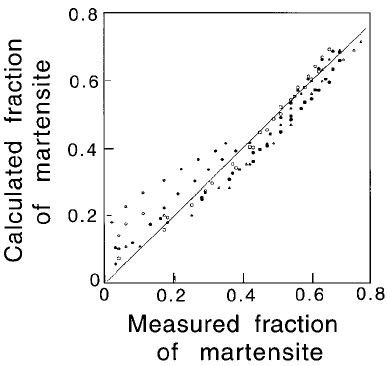
6.15 Summary
Both the individual platelets and the sheaves of bainite lengthen at rates much
faster than permitted by the diffusion of carbon. It must be concluded that they
grow with a supersaturation of carbon, the ferrite inheriting the composition of
the parent austenite. The excess carbon is soon afterwards partitioned into the
residual austenite or precipitates as carbides.
It is possible that not all the carbon is trapped in the ferrite during transfor-
mation. However, neither the experimental evidence nor the theory for growth
with partial supersaturation is convincing.
Carbon must partition during the nucleation of bainite. The nucleation prob-
ably occurs by a displacive mechanism akin to martensite, but with the most
potent sites con®ned to the austenite grain surfaces. Autocatalytic nucleation
plays a role but it is not as prominent for bainite as it is for martensite. The
activation energy for nucleation varies linearly with the driving force.
Nucleation does not therefore rely on heterophase ¯uctuations, but rather on
the dissociation of dislocation clusters. The activation energy is in these cir-
cumstances from the resistance to interfacial motion.
The calculation of overall transformation kinetics remains challenging.
Whereas some important trends are reproduced, accurate predictions using
few parameters are not yet possible. This indicates that important variables
remain to be identi®ed. A qualitative result is that bainitic transformation is
less sensitive to the austenite grain size when compared with pearlite. This is
Kinetics
187
Fig. 6.45 Comparison of experimental results with those calculated by ®tting
equation 6.60 to the experimental data. After Khan and Bhadeshia, 1990b.
because sheaf growth occurs by the propagation of sub-units at sites away
from the austenite grain surfaces.
Except at temperatures close to B
S
, homogeneous steels transform more
rapidly than those containing chemical segregation. The martensitic decompo-
sition of austenite left untransformed after the growth of bainite can be
described adequately by the theory for the martensitic decomposition of
fully austenitic samples.
Bainite in Steels
188

7 Upper & Lower Bainite
Although there have been attempts at generalising the de®nition of bainite, the
most appropriate description remains that the microstructure consists of a non-
lamellar mixture of ferrite and carbides, which can be classi®ed further into
upper and lower bainite. This latter distinction is of value because there are
clear differences in the mechanical properties of upper and lower bainite. The
two microstructures can easily be distinguished using transmission electron
microscopy and hence can be discussed in the context of mechanical properties
and the growth mechanism.
Lower bainite is obtained by transformation at relatively low temperatures.
Both upper and lower bainite form as aggregates of small plates or laths (sub-
units) of ferrite. The essential difference between them is in the nature of the
carbide precipitates. Upper bainitic ferrite is free of precipitation, any carbides
growing from the carbon-enriched residual austenite between the plates of
ferrite. In addition to this kind of precipitation, there are carbide particles
present inside lower bainitic ferrite. We shall see that the precipitates in
lower bainitic ferrite can be any of the carbides reported to occur during the
tempering of martensite, for example, , , or cementite.
7.1 The Matas and Hehemann Model
The transition between upper and lower bainite is believed to occur over a
narrow range of temperatures. It is possible for both forms to occur simult-
aneously during isothermal transformation near the transition temperature
(Pickering, 1967). Matas and Hehemann (1961) proposed that the difference
between upper and lower bainite comes from a competition between the rate at
which carbides can precipitate from ferrite and the speed with which carbon is
partitioned from supersaturated ferrite into austenite (Fig. 7.1). Upper bainite
forms at higher temperatures, permitting the excess carbon to partition before
it can precipitate in the ferrite. In lower bainite, the slower diffusion associated
with the reduced transformation temperature provides an opportunity for
some of the carbon to precipitate in the supersaturated ferrite.
A corollary is that upper bainite should not form when the carbon
concentration is large. This is indeed found to be the case in a Fe±7.9Cr±1.1C
wt% alloy which has a B
S
temperature of just 300 8C (Srinivasan and Wayman,
[13:31 3/9/01 C:/3B2 Templates/keith/3750 BAINITE.605/3750-007.3d] Ref: 0000 Auth: Title: Chapter 00 Page: 189 189-200
189
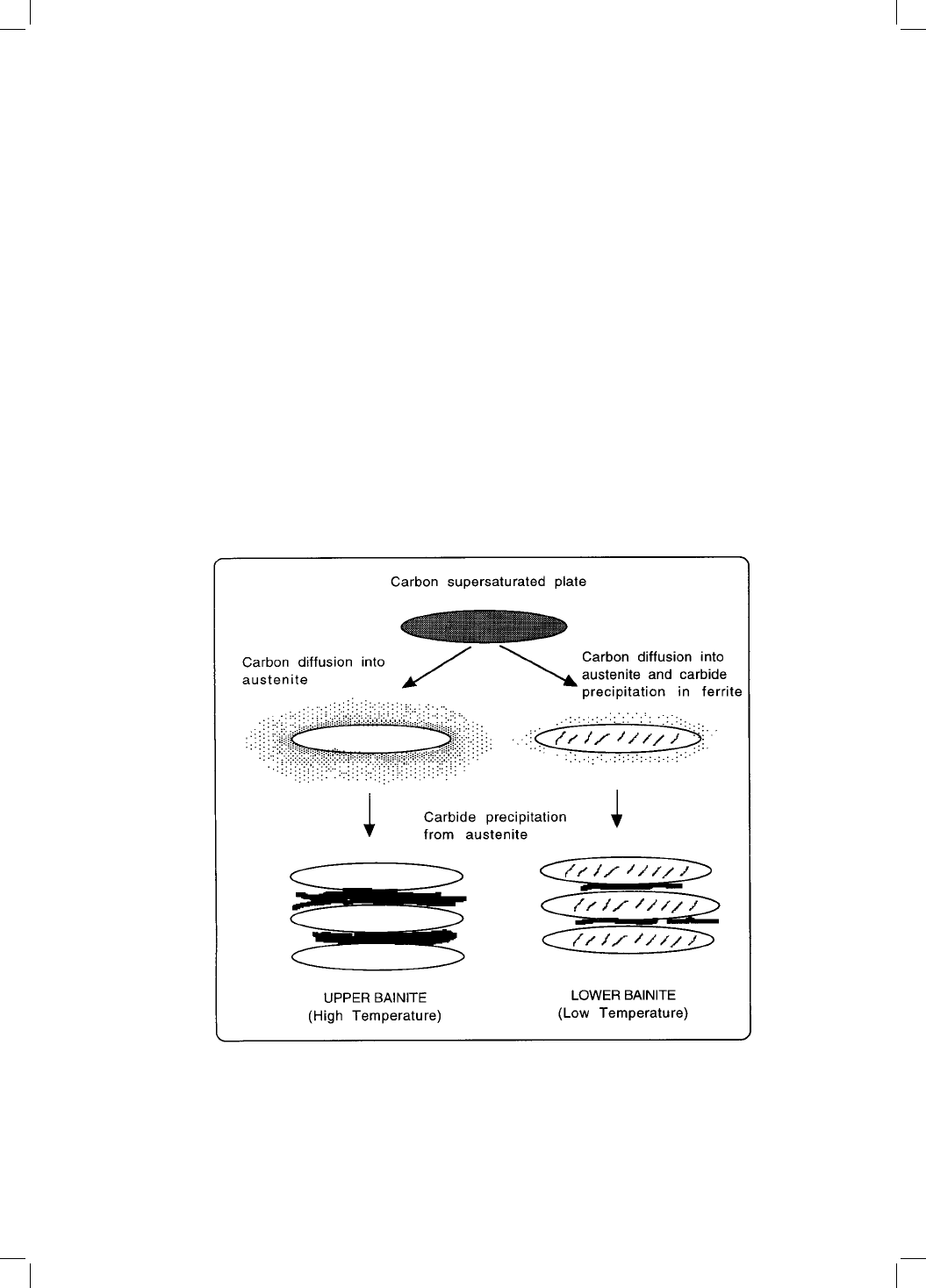
1968a), and in a Fe±4.08Cr±0.3C wt% alloy which has a B
S
temperature of
490 8C. Ohmori and Honeycombe (1971) have shown that in a series of high
purity Fe±0.16±0.81C wt% alloys, lower bainite is not obtained when the carbon
concentration is less than about 0.4 wt%. Tsuzaki et al: (1991) found a similar
result for Fe±Si±C alloys; only upper bainite formed in a Fe±2Si±1Mn±0.34C
wt% steel, whereas both upper and lower bainite could be observed when a
higher carbon variant (0.59 wt%) was examined. A thorough piece of work by
Oka and Okamoto (1986) on high purity, high carbon Fe±0.85±1.8C wt% steels
has shown the absence of upper bainite in all cases. The formation of pearlite
was in each case found to give way directly to that of lower bainite.
The model illustrated in Fig. 7.1 has been expressed quantitatively by com-
paring the time required to decarburise supersaturated ferrite against cemen-
tite precipitation kinetics (Takahashi and Bhadeshia, 1990).
Bainite in Steels
[13:31 3/9/01 C:/3B2 Templates/keith/3750 BAINITE.605/3750-007.3d] Ref: 0000 Auth: Title: Chapter 00 Page: 190 189-200
190
Fig. 7.1 Schematic representation of the transition from upper to lower bainite.
After Takahashi and Bhadeshia (1990).
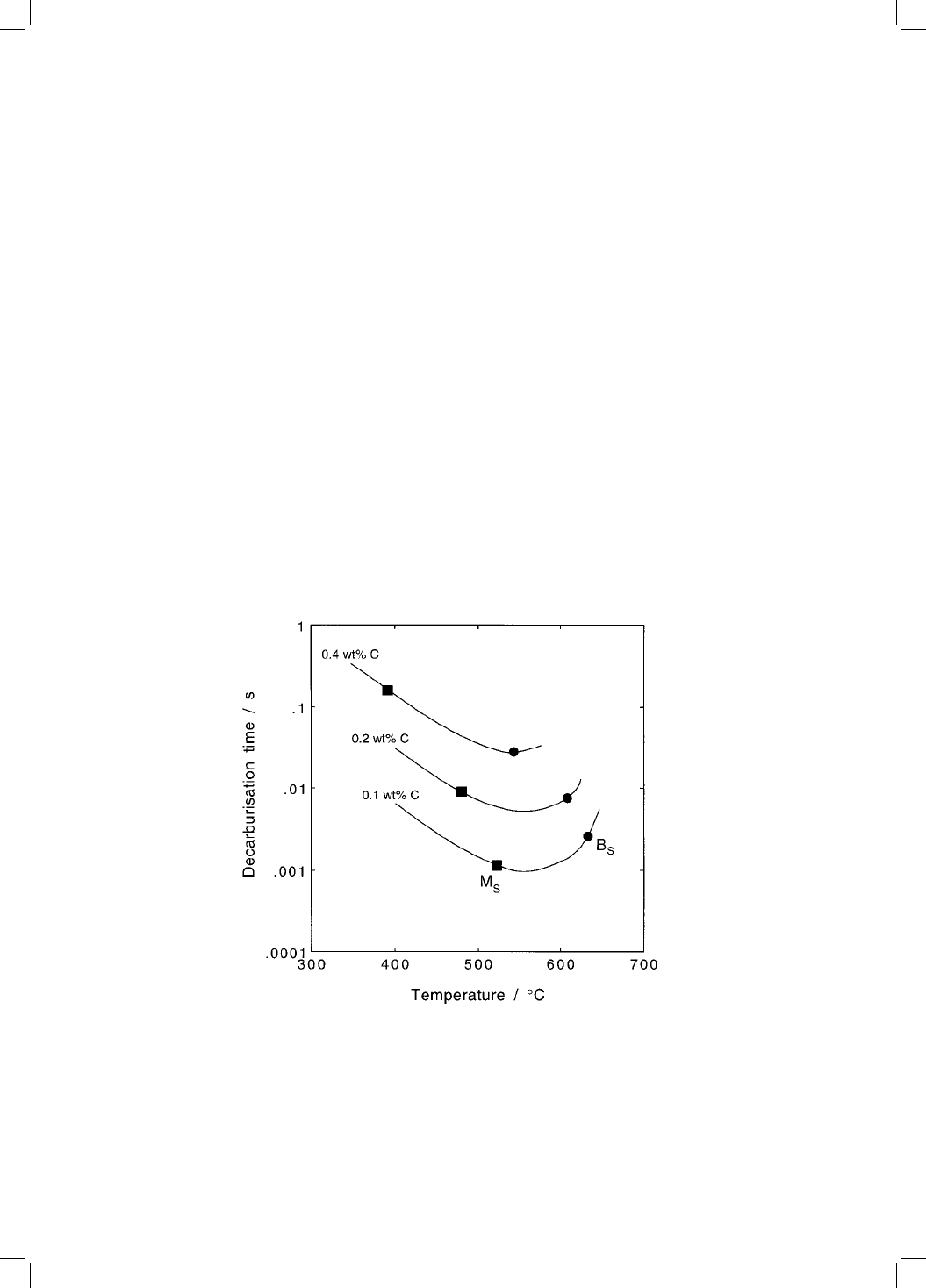
7.2 Quantitative Model
7.2.1 Time to Decarburise Supersaturated Ferrite
The theory for the partitioning of carbon from a supersaturated plate of ferrite
has been presented in Chapter 6. The diffusion coef®cient of carbon in ferrite is
greater than that in austenite. This, together with the assumption that there is
local paraequilibrium at the = interface, gives the time t
d
required to
decarburise a plate of a speci®ed thickness (equation 6.28). Some results for
plain carbon steels are presented in Fig. 7.2. In each case, t
d
is found to go
through a minimum as a function of the transformation temperature. This is
because the diffusion coef®cient of carbon decreases with temperature (leading
to an increase in t
d
), while at the same time, the amount of carbon that the
austenite can tolerate increases at lower temperatures.
7.2.2 Kinetics of Cementite Precipitation
It is not yet possible to estimate the rate of cementite precipitation from super-
saturated ferrite as a function of time, temperature and chemical composition.
Upper & Lower Bainite
[13:31 3/9/01 C:/3B2 Templates/keith/3750 BAINITE.605/3750-007.3d] Ref: 0000 Auth: Title: Chapter 00 Page: 191 189-200
191
Fig. 7.2 Calculated time for the decarburisation of supersaturated ferrite plates (of
thickness 0.2 m) in plain carbon steels with 0.1, 0.2 and 0.4 wt% carbon
respectively. The calculated martensite-start and bainite-start temperatures are
also indicated.
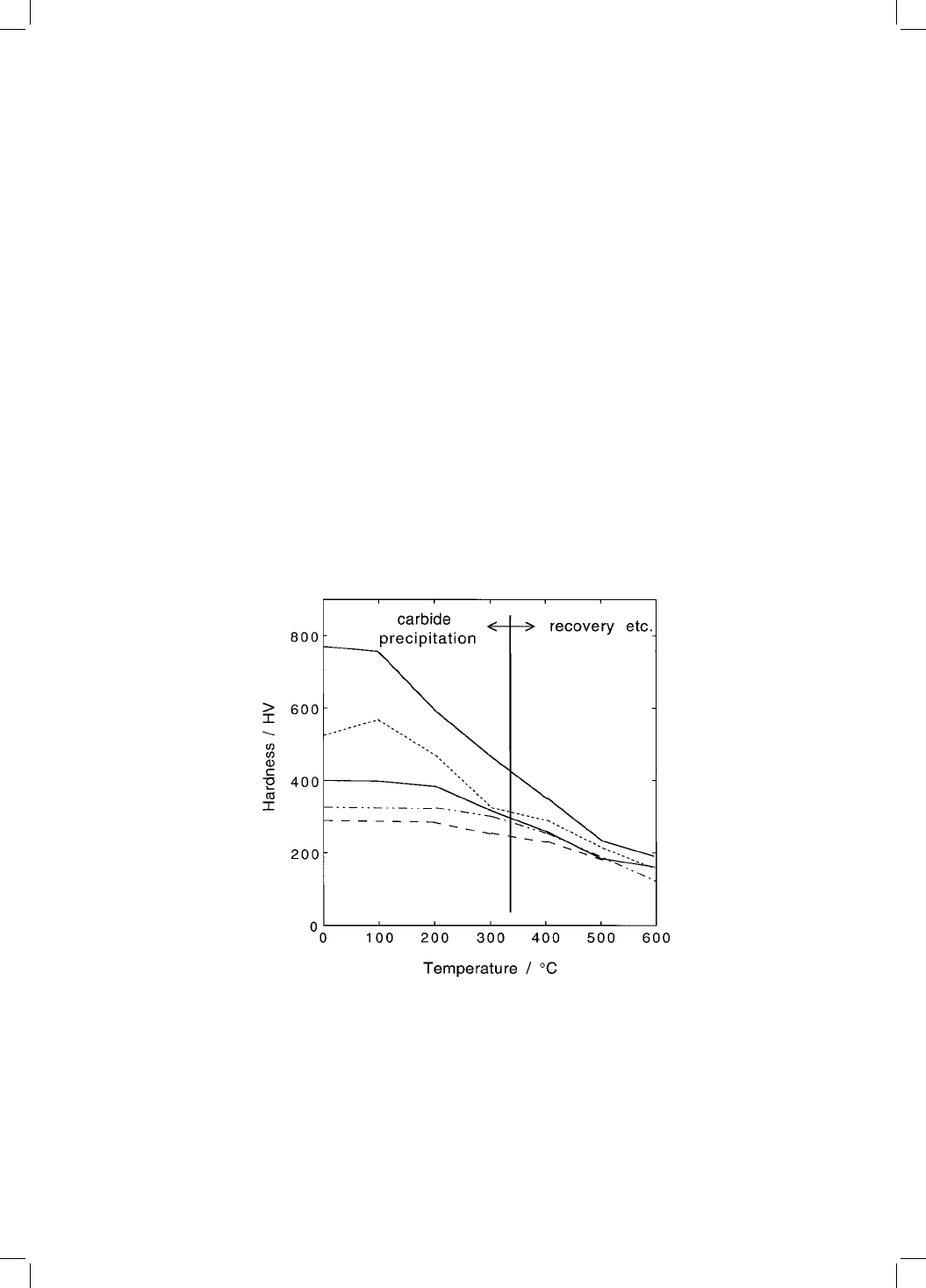
However, for plain carbon steels, and in some cases for alloy steels, martensite
tempering data can be adapted to derive reasonable functions for the purpose
of predicting the transition from upper to lower bainite (Takahashi and
Bhadeshia, 1990, 1991).
The ®rst change that happens during the tempering of supersaturated
martensite is that the excess carbon precipitates in the form of carbides.
Prolonged annealing can also lead to recovery, recrystallisation and the
coarsening of cementite precipitates. To derive a function representing pre-
cipitation alone, it is necessary to focus on the early stages of tempering.
Speich (1969) reported that the change in hardness of martensite in plain
carbon steels after an hour of tempering at temperatures above 320 8C, includes
signi®cant contributions from recovery, recrystallisation and coarsening of
cementite particles (Fig. 7.3). The data representing hardness changes during
tempering below 320 8C can be used to derive a function which expresses the
change in the volume fraction of cementite precipitation as a function of time
and temperature. An Avrami equation can then be used empirically to
represent the tempering reaction:
Bainite in Steels
[13:31 3/9/01 C:/3B2 Templates/keith/3750 BAINITE.605/3750-007.3d] Ref: 0000 Auth: Title: Chapter 00 Page: 192 189-200
192
Fig. 7.3 Hardness curves for iron±carbon martensitic samples which were
tempered for 1 hour at the temperatures indicated; the ®ve curves represent steels
with different carbon concentrations (data due to Speich, 1969). The data to the left
of the vertical line re¯ect changes due to the precipitation of carbides rather than
recovery or coarsening processes.

ftg1 expfk
A
t
n
g7:1
where ftg is the volume fraction of cementite normalised by its equilibrium
volume fraction at the reaction temperature, t is the time, and k
A
and n are rate
constants determined from the experimental data. Since it is assumed that ftg
is related at any time to the hardness of the martensite, Hftg, it follows that:
ftgH
0
Hftg=H
0
H
F
7:2
H
0
is the hardness of the as-quenched virgin martensite, H
F
is its hardness
when all the carbon has precipitated but before any signi®cant recovery,
recrystallisation or coarsening has occurred. The assumption here is that the
amount of carbon precipitated is related linearly to the change in hardness
during the early stages of tempering.
Using the values of hardness for plain carbon martensite tempered for 1
hour at 320 8C, reported by Speich, H
F
can be expressed empirically as a func-
tion of the initial hardness and average carbon concentration
x (mole fraction),
as follows:
H
F
H
0
1 1:731x
0:34
7:3
This equation is valid for plain carbon steels containing less than 0.4 wt%
carbon, the value of H
F
becoming constant thereafter. The hardness H
0
of
plain carbon martensite (< 0:4 wt% carbon) before tempering can be also be
deduced from the data reported by Speich:
H
0
1267weight % carbon
0:9
240 7:4
where the hardness of martensite in pure iron is 240 HV (Leslie, 1982). This
equation gives the hardness of virgin martensite in plain carbon steels as a
function of dissolved carbon. There is evidence that the effect of carbon tends
eventually to saturate, so H
0
should be set not exceed about 800 HV
irrespective of the carbon concentration (Bhadeshia and Edmonds, 1983a,b).
Having established all the data necessary to estimate the amount of cementite
precipitated, it remains to evaluate the terms k
A
and n of the Avrami equation
in order to calculate the time t
for the formation of a speci®ed fraction of
cementite as a function of time, temperature and carbon concentration. This
can easily be done by ®tting the Avrami equation to experimental data on the
tempering of martensite.
There are more elaborate theories available for the change in the strength of
low-carbon martensite due to the precipitation of cementite, making it possible
to estimate H
0
H
F
independently of the empirical approach described above.
The change can be expressed in terms of the decrease in solid solution
strengthening as carbon is incorporated into cementite, and a lesser increase
in strength as the cementite particles precipitation harden the martensite. Thus,
Upper & Lower Bainite
[13:31 3/9/01 C:/3B2 Templates/keith/3750 BAINITE.605/3750-007.3d] Ref: 0000 Auth: Title: Chapter 00 Page: 193 189-200
193

the yield strength of martensite,
y
, is expressed as a combination of the intrin-
sic yield strength, the effect of the dislocation cell structure, and precipitation
hardening by cementite (Daigne et al:, 1982):
y
0
k
1
1
k
p
1
; MPa 7:5
where
0
is the intrinsic strength of martensite (including solid solution
strengthening due to carbon),
1
is the average transverse thickness of the
cell structure, and is the average distance between a particle and its two
or three nearest neighbours. The data needed to evaluate the equation are well-
founded. A comparison of the calculated strength and measured strength after
tempering should give a good idea of the extent of cementite precipitation.
When this is done, the relation between hardness and the amount of the pre-
cipitation (thus the decrease in solute carbon) is found not to be linear as was
assumed in the empirical approach, but the predicted changes in hardness are
found to be remarkably consistent with those measured by Speich for the early
stages of tempering. This justi®es the assumption that much of the hardness
change can be attributed to the precipitation of carbon rather than due to other
annealing effects such as tempering.
7.2.3 Quantitative Estimation of the Transition Temperature
Following the gist of the Matas and Hehemann proposal, a comparison of the
time t
d
required to decarburise a plate of ferrite, with the time interval t
necessary to obtain a detectable amount of cementite precipitation in the ferrite
should give a good indication of whether upper or lower bainite is expected
during isothermal transformation. If t
d
< t
then it may be assumed that upper
bainite is obtained, and vice versa (Fig. 7.4). A weakness of this theoretical
model is that decarburisation and precipitation should really be coupled. A
disposable parameter in the model as it stands is the `detectable amount' of
cementite precipitation, which has to be ®xed by comparison with
experimental data.
Some calculated data on the plain carbon steels are presented in Fig. 7.5.
They indicate that lower bainite should not be observed in plain carbon steels
with carbon concentrations less than 0.32 wt%. Furthermore, only lower bainite
(i.e. no upper bainite) is expected in steels with carbon concentrations
exceeding 0.4 wt%. Steels containing between 0.32 and 0.4 wt% of carbon
should exhibit both both upper and lower bainite, depending on the reaction
temperatures. Finally, at low temperatures where t
and t
d
both become large,
the times required for precipitation or redistribution of carbon exceed that to
complete transformation, consistent with the fact that untempered martensite
Bainite in Steels
[13:31 3/9/01 C:/3B2 Templates/keith/3750 BAINITE.605/3750-007.3d] Ref: 0000 Auth: Title: Chapter 00 Page: 194 189-200
194
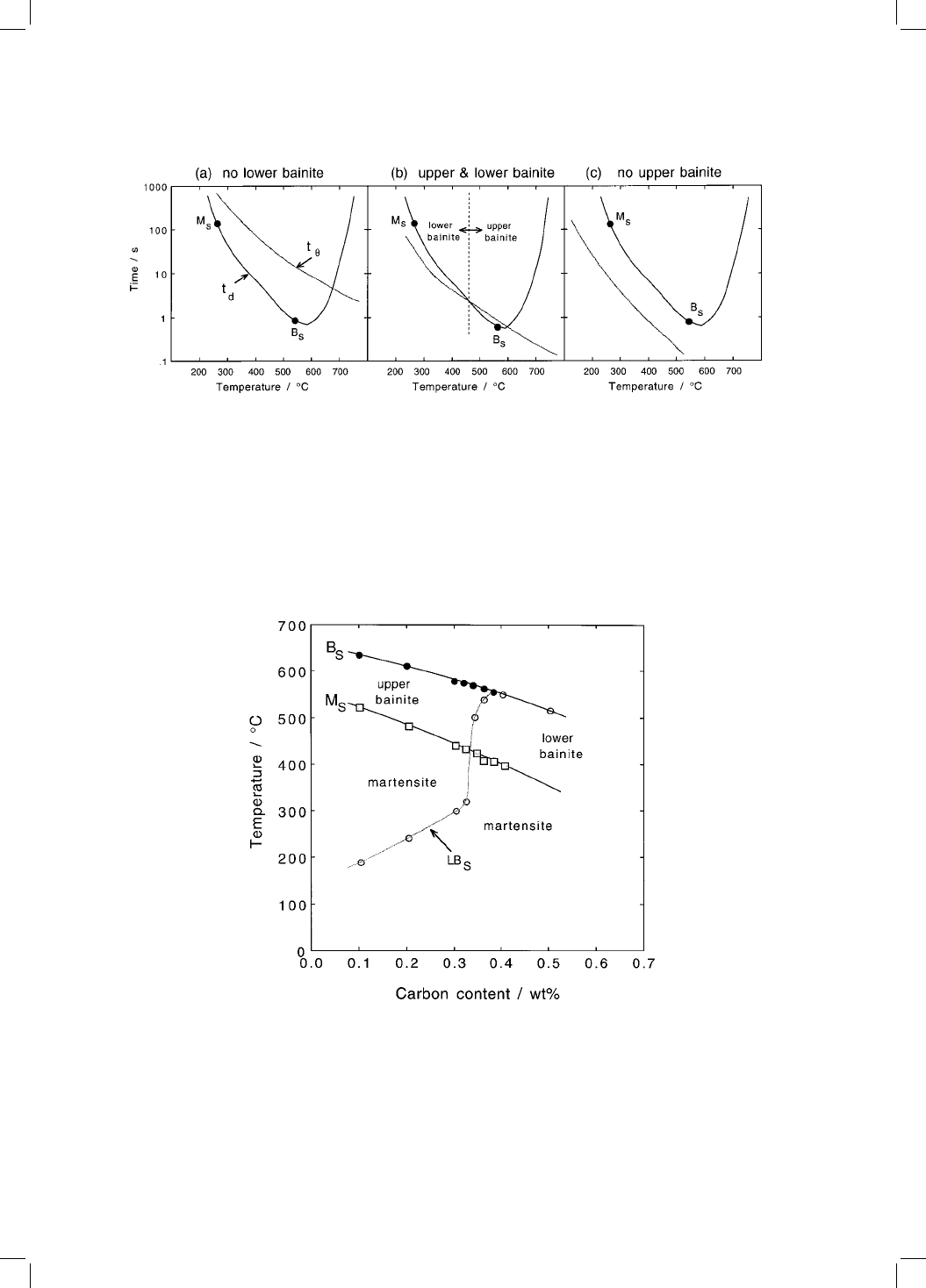
Upper & Lower Bainite
[13:31 3/9/01 C:/3B2 Templates/keith/3750 BAINITE.605/3750-007.3d] Ref: 0000 Auth: Title: Chapter 00 Page: 195 189-200
195
Fig. 7.4 Illustration of how differences in the relative variation of the decarbur-
isation time t
d
and the precipitation time t
can lead to: (a) a steel which is
incapable of transforming to lower bainite; (b) a steel which should, under
appropriate conditions, be able to transform to upper or lower bainite; (c) a
steel in which bainitic transformation always leads to the formation of lower
bainite.
Fig. 7.5 Calculated lower bainite transformation start temperatures for plain
carbon steels, as a function of transformation temperature. The calculated
martensite-start and bainite-start temperatures are also presented. After
Takahashi and Bhadeshia, 1990.

can be obtained at temperatures near M
S
, with the degree of autotempering of
the martensite decreasing as M
S
is reduced.
7.2.4 Comparison of Theory and Experimental Data
The general behaviour indicated by the calculations for plain carbon steels, is
found to be that observed experimentally. Some interesting work by Oka and
Okamoto (1986) proves that there is no upper bainite in plain carbon steels
with more than 0.8 wt% of carbon; the only bainite observed in their experi-
ments was classical lower bainite at all temperatures above the M
S
temperature
(Fig. 7.6a).
Ohmori and Honeycombe (1971), in a study of plain carbon steels, showed
that during isothermal transformation above M
S
, only upper bainite could be
obtained in samples containing less than 0.4C wt% (Fig. 7.6b). This is consistent
with theory, although their observation that upper bainite can be obtained in
steels with a carbon concentration up to about 0.85C wt% is not consistent with
the theory, nor with the data reported by Oka and Okamoto (1986).
7.3 Mixed Microstructures Obtained By Isothermal
Transformation
According to the analysis presented above, only lower bainite is expected in
plain carbon steels with more than 0.32 wt% of bulk carbon content. However,
the calculations are for ferrite plates whose carbon concentration is at ®rst
identical to that of the bulk alloy. As transformation proceeds the austenite
becomes enriched in carbon. The bainite which grows from this enriched aus-
tenite will inherit a higher than bulk concentration of carbon. This leads to the
possibility of upper bainite being followed by lower bainite during isothermal
transformation. Mixed microstructures should therefore be obtained in plain
carbon steels containing less than 0.32 wt% carbon, especially if the rate of
carbide precipitation from the austenite is slow enough to allow the austenite
to become enriched.
The maximum carbon concentration that can be tolerated in residual auste-
nite before the bainite reaction stops is given by the T
0
0
curve. Therefore if the
carbon concentration in residual austenite at the T
0
0
curve (i.e. x
T
0
0
) is greater
than 0.32 wt%, lower bainite can form during the later stages of transformation.
However, the formation of cementite from the residual austenite also
becomes possible if x
T
0
0
> x
, where x
is a point on the = phase
boundary, since the austenite will then be supersaturated with respect to the
cementite. The fact that a curve showing the carbon concentration in austenite
which is in equilibrium with cementite in plain carbon steels crosses the T
0
0
Bainite in Steels
[13:31 3/9/01 C:/3B2 Templates/keith/3750 BAINITE.605/3750-007.3d] Ref: 0000 Auth: Title: Chapter 00 Page: 196 189-200
196
